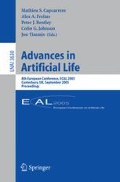Abstract
A self-reproducing cycle has the fundamental organization, \(A+X \longrightarrow 2A\), and is autocatalytic, i.e. the products catalyze the formation of the products. The rate of increase of A is proportional to A, i.e. exponential. Asexual living entities often grow exponentially when resources are abundant, and decay exponentially when resources are scarce, according to autocatalytic kinetics. If two previously independently replicating autocatalytic entities can form a physical union that is still capable of autocatalysis but with a reduced decay rate, then the symbiosis can be viable in an environment in which resources have been depleted, even if the symbiont has a lower growth rate than either of its component particles. A good symbiont possesses the following features: i. low steric hindrance between components, ii. policing of defection or cheating by symbiont components. iii. low decay rate back to components. iv. absence of emergence of active sites susceptible to decay reactions. v. high rate of the final reproductive step. Failure to form stable symbiosis can result from deficits in any of these features, and is a problem central to the origin of both metabolism and template replication.
Access this chapter
Tax calculation will be finalised at checkout
Purchases are for personal use only
Preview
Unable to display preview. Download preview PDF.
References
King, G.A.M.: Autocatalysis. Chem. Soc. Rev. 7, 297–316 (1978)
King, G.A.M.: Recycling, Reproduction and Lifes Origins. Biosystems 15, 89–97 (1982)
King, G.A.M.: Symbiosis and the Origin of Life. Origins Life 8, 39–53 (1976)
Ganti, T.: The Principles of Life. Oxford University Press, Oxford (2003)
Ganti, T.: Chemoton Theory Vol I and II. Kluwer, Dordrecht (2004)
Maynard-Smith, J., Szathmary, E.: The Major Transitions in Evolution. Oxford University Press, Oxford (1995)
Kauffman, S.: Autocatalytic Sets of Proteins. J. Theoret. Bio. 119, 1–24 (1986)
Farmer, J.D., Kauffman, S.A., Norman, H.: Packard Autocatalytic replication Polymers. Physica D 22, 50–67 (1986)
Stadler, B.M.R., Stadler, P.F.: Molecular Replicator Dynamics Adv. Complex Systems 6, 47–77 (2003)
Eigen, M., Schuster, P.: The Hypercycle: A principle of natural self-organization. Springer, Berlin (1979)
Richard, E.: Michod Darwinian Dynamics: Evolutionary Transitions in Fitness and Individuality. Princeton University Press, Princeton (1999)
Breslow, R.: Tetrahedron. Letters 21, 22–26 (1959)
Decker, P., Schwoer, H., Pohlmann, R.: Bioids. Journal of Chromatography 224, 281–291 (1982)
Wachterschauser, G.: Microbiol. Rev. 52, 452–484 (1988)
Smith, E., Morowitz, H.J.: Universality in Intermediary Metabolism. PNAS 101(36), 13168–13173 (2004)
Mossel, E., Steel, M.: Random Biochemical Networks: the probability of self-sustaining autocatalysis. Journal of Theoretical Biology (forthcoming)
Taming Combinatorial Explosion. PNAS 97(14), 7678–7680 (2000)
Szathmary, E.: The Evolution of Replicators. Philos. Trans. R. Soc. Lond B. Biol Sci. 29(355), 1669–1676 (2000)
Szathmary, E., Santos, M., Fernando, C.: Evolutionary Potential and Requirements for Minimal Protocells Topics in Chemistry (forthcoming)
Fontana, W., Buss, L.W.: The Arrival of the Fittest: Toward a Theory of Biological Organization. Bulletin of Mathematical Biology 56, 1–64 (1994)
Margulis, L.: Symbiosis in Cell Evolution, 2nd edn. Freeman, New York (1993)
Lovelock, J.E.: Gaia: A New Look at Life on Earth. Oxford University Press, Oxford (1979)
Author information
Authors and Affiliations
Editor information
Editors and Affiliations
Rights and permissions
Copyright information
© 2005 Springer-Verlag Berlin Heidelberg
About this paper
Cite this paper
Fernando, C. (2005). The Good Symbiont. In: Capcarrère, M.S., Freitas, A.A., Bentley, P.J., Johnson, C.G., Timmis, J. (eds) Advances in Artificial Life. ECAL 2005. Lecture Notes in Computer Science(), vol 3630. Springer, Berlin, Heidelberg. https://doi.org/10.1007/11553090_70
Download citation
DOI: https://doi.org/10.1007/11553090_70
Publisher Name: Springer, Berlin, Heidelberg
Print ISBN: 978-3-540-28848-0
Online ISBN: 978-3-540-31816-3
eBook Packages: Computer ScienceComputer Science (R0)

